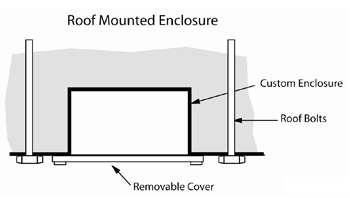Mining Contract: System Reliability and Environmental Survivability
| Contract # | 200-2008-26864 |
|---|---|
| Start Date | 9/1/2008 |
| End Date | 10/31/2009 |
| Research Concept |
This contract will develop a practical, objective methodology with appropriate metrics, procedures, and technical guidelines that enables mine operators and enforcement agencies to evaluate the reliability and survivability of underground communications, tracking, and atmospheric monitoring systems (AMS). The model will calculate reliability and survivability (R&S) based on known or estimated component and system level parameters for both routine and emergency communication, tracking, atmospheric monitoring, and power systems. This information will also be useful in improving reliability (communication coverage, equipment placement and optimization, interference issues, etc.) of existing or proposed systems and environmental survivability following a mine disaster, mine emergency, or other abnormal circumstance. |
| Topic Areas |
Contract Status & Impact
This contract is complete. To receive a copy of the final report, send a request to mining@cdc.gov.
The simplest hardening technique is to mount components in crosscuts and out of main entries. This protects equipment and any cabling from debris and at least 1/3 of the total blast pressure for a blast wave traveling down a main entry. Another simple technique is to install equipment away from areas at risk for explosion such as working faces or gob seals. Locations over 1,000 feet from these areas should not experience significant blast pressure or debris from methane explosions. Other areas to avoid include beltways, wet locations, and areas subject to roof falls. However, equipment often must be located in these areas, and in such cases, hardening and redundancy techniques should be used.
Practical hardening techniques are currently available and easily implemented. Rigid attachment of cables to the roof or upper rib with attachments spaced a maximum of five feet apart provides significant protection for cables from blast pressures. Using blast shields for cables at passage intersections addresses a common cable failure point. Rugged enclosures should survive blast pressures so the most useful hardening technique is to attach these to the rib or roof using rock bolts.
Hardening against debris is more challenging. The only approaches that can withstand debris forces close to a large explosion are some form of burial or grouting. These can be problematic for systems utilizing RF.
Redundancy techniques are currently in use. Wireless mesh networks are inherently redundant. A simple and relatively low-cost redundant technique is use of a loopback cable that exits the mine through a borehole or portal not used by the primary cable.
The contractor's review of tracking system accuracy indicates that tracking systems might have been of benefit in eight accidents when used in conjunction with communications systems and lifelines. Tracking systems alone would likely have saved lives in six accidents. In situations where communications with miners is available, the key benefit of tracking is to allow surface personnel to direct escaping miners to safety. Where communication is not available, the key benefit of tracking is to allow rescuers to quickly locate, treat, and evacuate injured miners. Depending on the incident, required tracking accuracies are 500 feet if the location can be isolated to a single passageway (entry or crosscut). Otherwise, 100 feet is required. In cases of low visibility (for example, heavy smoke), accuracy to 10 feet may be required to locate injured individuals.
The contractor demonstrated its model and methodology for assessing the reliability and survivability of communications, atmospheric monitoring, and tracking systems. The contractor exercised the model on four systems including survivability assessments of two disaster scenarios: an explosion at a working face and a system failure in main entries.

- Development of a Uniform Methodology for Evaluating Coal Mine Tracking Systems
- Emergency Communications and Tracking
- Mine Rescue Training Simulations and Technology
- Mobile Adaptable RF/IT Infrastructure - Experimental (MATRIX)
- Refuge Alternatives in Underground Coal Mines
- Refuge Chamber Deployment and Occupancy Status During Mine Emergency Situations
- Sprinkler Head Emergency Communications
- Survey of Electromagnetic and Seismic Noise Related to Mine Rescue Communications: Volume I - Emergency and Operational Mine Communications
- Survey of Electromagnetic and Seismic Noise Related To Mine Rescue Communications: Volume II - Seismic Detection and Location of Isolated Miners
- Technology News 543 - Reverse Implementation of Radio Frequency Identification (RFID) Technology for Personnel Tracking in Underground Mines